Site pages
Current course
Participants
General
MODULE 1. Introduction to mechanics of tillage tools
MODULE 2. Engineering properties of soil, principl...
MODULE 3. Design of tillage tools, principles of s...
MODULE 4. Deign equation, Force analysis
MODULE 5. Application of dimensional analysis in s...
Module 6. Introduction to traction and mechanics, ...
Module 7. Traction model, traction improvement, tr...
Module 8.Soil compaction and plant growth, variabi...
LESSON 5. PHYSICAL PROPERTIES OF SOILS
5.1. INTRODUCTION
The term Soil has various meanings, depending upon the general field in which it is being considered. To a Pedologist, it is the substance existing on the earth's surface, which grows and develops plant life. To a Geologist, it is the material in the relative thin surface zone within which roots occur, and all the rest of the crust is grouped under the term ROCK irrespective of its hardness. To an Engineer, it is the un-aggregated or un-cemented deposits of mineral and/or organic particles or fragments covering large portion of the earth's crust.
Soil material is the product of rock. The geological process that produce soil is WEATHERING, Chemical and/or Physical.
Variation in Particle size and shape depends on
i. Weathering Process, and
ii. Transportation Process.
Variation in Soil Structure Depends on
i. Soil Minerals,
ii. Deposition Process and
iii.Transportation and Deposition.
Different types of soil produced by the different weathering & transportation process include
i. Boulders,
ii. Gravel,
iii. Cohesionless Sand (Physical),
iv. Silt,
v. Cohesive Clay (Chemical).
These soils can be Dry, Saturated - Fully or Partially. Also they have different shapes and textures.
Soil Mechanics is one of the youngest disciplines of Civil Engineering involving the study of soil, its behavior and application as an engineering material. According to Terzaghi (1948): "Soil Mechanics is the application of laws of mechanics and hydraulics to engineering problems dealing with sediments and other unconsolidated accumulations of solid particles produced by the mechanical and chemical disintegration of rocks regardless of whether or not they contain an admixture of organic constituent."
Geotechnical Engineering is a broader term for Soil Mechanics. Geotechnical Engineering contains:
Soil Mechanics (Soil Properties and Behavior),
Soil Dynamics (Dynamic Properties of Soils,
Earthquake Engineering,
Machine Foundation),
Foundation Engineering (Deep & Shallow Foundation),
Pavement Engineering (Flexible & Rigid Pavement),
Rock Mechanics (Rock Stability and Tunneling), and
Geosynthetics (Soil Improvement)
5.1.1. Mechanics of tillage
The reactions of soils to forces applied by tillage tools are affected by the resistance to compression, the resistance to shear, adhesion (attraction forces between the soil and other material) and frictional resistance. These are all dynamic properties in that they are made manifest only through movement of soil. Acceleration forces are not a property of soil but are also present. Nichols has shown that reactive forces of all classes of soils are dominated by the film moisture on the colloidal particles and are thus directly related to the soil moisture and colloidal content.
Soils may be classified as plastic and nonplastic; the term plastic implying that the soil is moldable within a certain range of moisture contents and that it will retain its molded shape after drying. Sands or other soils containing less than 15 to 20% colloids are clay are generally considered to be nonplastic. If a plastic soil is saturated with water and then allowed to dry, it passes through the following stages, in order: sticky, plastic, friable (crumbly) and hard (cemented). The friable stage represents optimum conditions for tillage. Soil compaction by tillage implements and power units, which is a serious problem in some areas, is promoted by working the soil when too wet.
Practically all tillage tools consist of devices for applying pressure to the soil, often by means of inclined planes or wedges. As tool advances, the soil in its path is subjected to compressive stresses which, in a friable (uncemented) soil, result in a shearing action.
The shearing of soil is considerably different from the shearing of most solids, in that the reaction may extend for a considerable distance on either side of the shear plane because of internal friction and the cohesive action of moisture films.
5.1.2. Engineering Properties of Soil
Soil is composed of three phases of matter – solid, liquid (water) and gas(air) (figure 1.1). The texture (grain sizes) in a soil will determine how it will behave in the absence and presence of water.
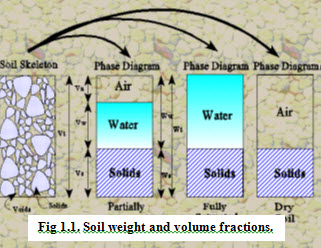
5.2. Physical properties of soils
i. Soil texture
One aspect of the physical properties of soil, its texture, is described by the percent of particles in various size classes (Table 2.1). Particle size is the defining difference between sand, silt, and clay, but of course the size of the particle has much to do with its other properties.
Table 2.1. USDA soil particle size definitions.
|
Particle class |
Size (diameter) |
|
Clay |
Less than 0.002 mm |
|
Silt |
0.002 – 0.05 mm |
|
Sand |
0.05 – 2.0 mm |
|
Gravel, Stone |
larger |
Natural soils are nearly always mixtures of sand, silt, and clay particles, as well as organic matter and stones. One convenient method of naming soils is the soil texture triangle (Figure 1.2). The sides of the triangle are axes, each representing the percentages of sand, silt, and clay that constitute the soil. Special names are assigned to various combinations as designated by the areas within the triangle.
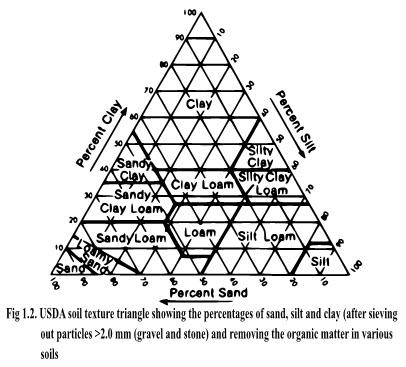
Thus, if a soil is composed of 40% sand, 35% silt, and 25% clay, it is called a loam. This is noted by the * in the figure. Note that because of the importance of the surface area-to-volume ratio, soils with as little as 20% clay still are called clay soils. There are various laboratory methods of measuring the relative amounts of sand, silt, and clay, but a field key such as Figure 1.3 gives useful results.
ii. Porosity (n)
It is a measure of the relative amount of voids in the soil. It is the ratio of the void volume (Vv) to the total volume (V) of the soil sample (Figure 2.3).
![]() --------------------------------- (2.1)
--------------------------------- (2.1)
iii. Void ratio (e)
It is the ratio of the void volume (Vv) to the volume of the solids (Vs)in a soil sample.
![]() ----------------------------- (2.2)
----------------------------- (2.2)
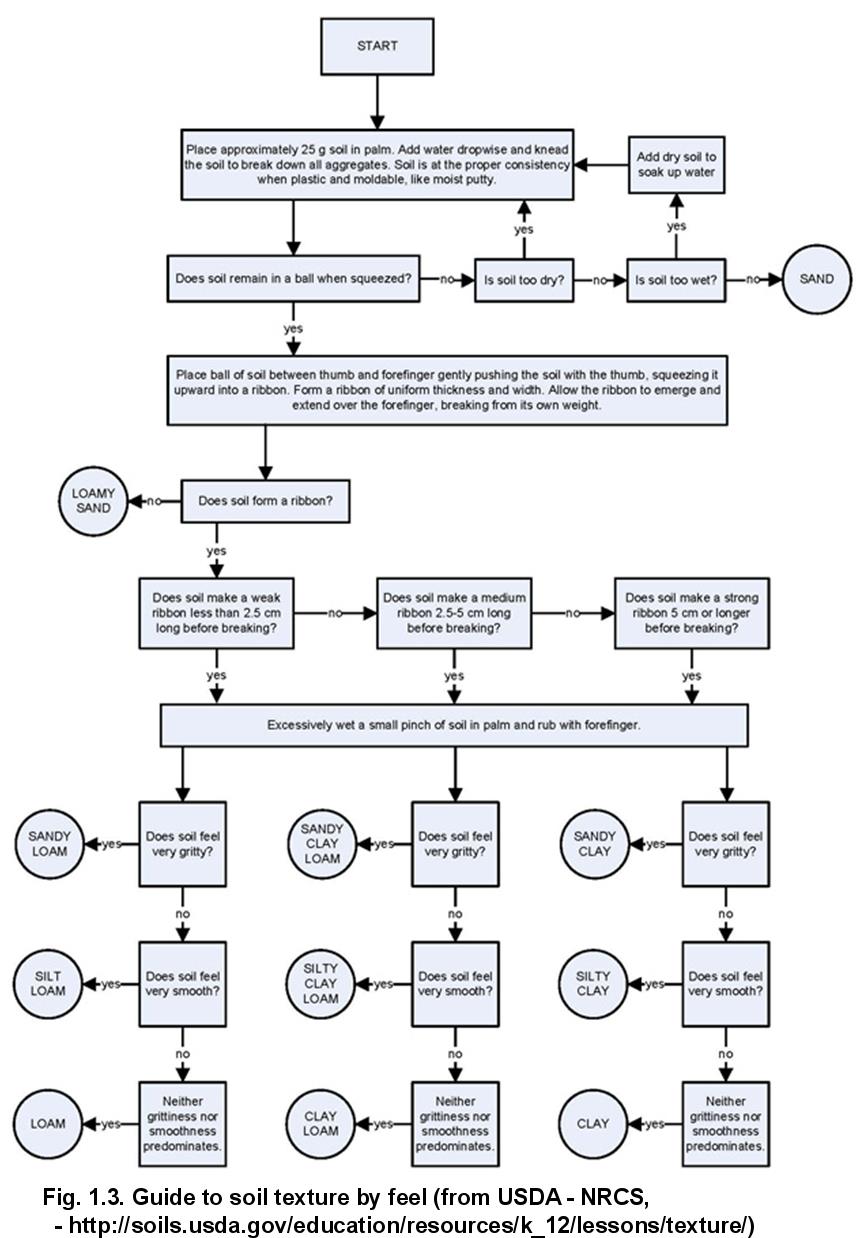
iv. Water content of the soil (w)
It is the ratio of the weight of water (Ww) to that of the solids (Ws) expressed as a percentage.
![]() ------------------------------------ (2.3)
------------------------------------ (2.3)
v. Degree of saturation (Sr)
It is the percentage of void space that is occupied by water.
![]() ---------------------------------------------- (2.4)
---------------------------------------------- (2.4)
vi. Unit weight or density (γ)
It is the ratio of the weight of the soil (W) to the volume of the soil (V). In other words, it is the weight of unit volume of soil.
 ----------------------------------- (2.5)
----------------------------------- (2.5)
vii. Dry density (γd)
It is the ratio of the weight of solids (Ws) to the total volume of soil (V).
![]() -------------------------------------------------- (2.6)
-------------------------------------------------- (2.6)
viii. Density of the solid particles in the soil (γs)
It is the ratio of the weight of the solids (Ws) to the volume of solids (Vs)
![]() -------------------------------------------------- (2.7)
-------------------------------------------------- (2.7)
The density of the solids in soils is found to be somewhat constant. It generally remains between 2.6 and 2.8 g cm-3. The average value is 2.65 g cm-3 for sand and silt and 2.75 g cm-3 for clay.
ix. Atterberg Limits

Liquid Limit (LL): It is the moisture content at which soil changes from a plastic solid to liquid. It is the change of consistency from plastic to liquid state.
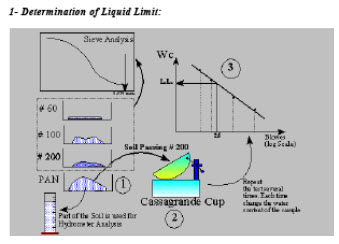
Plastic Limit (PL): It is the moisture content below which soil changes from plastic to crumbly solid. It is the change of consistency from brittle/crumbly to plastic state.
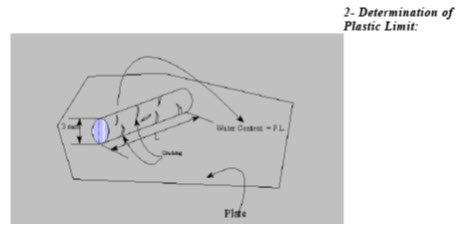
Plasticity Index (PI): It is the difference between liquid limit (LL) and plastic limit (PL).
PI = LL - PL ------------------------------------ (2.8)